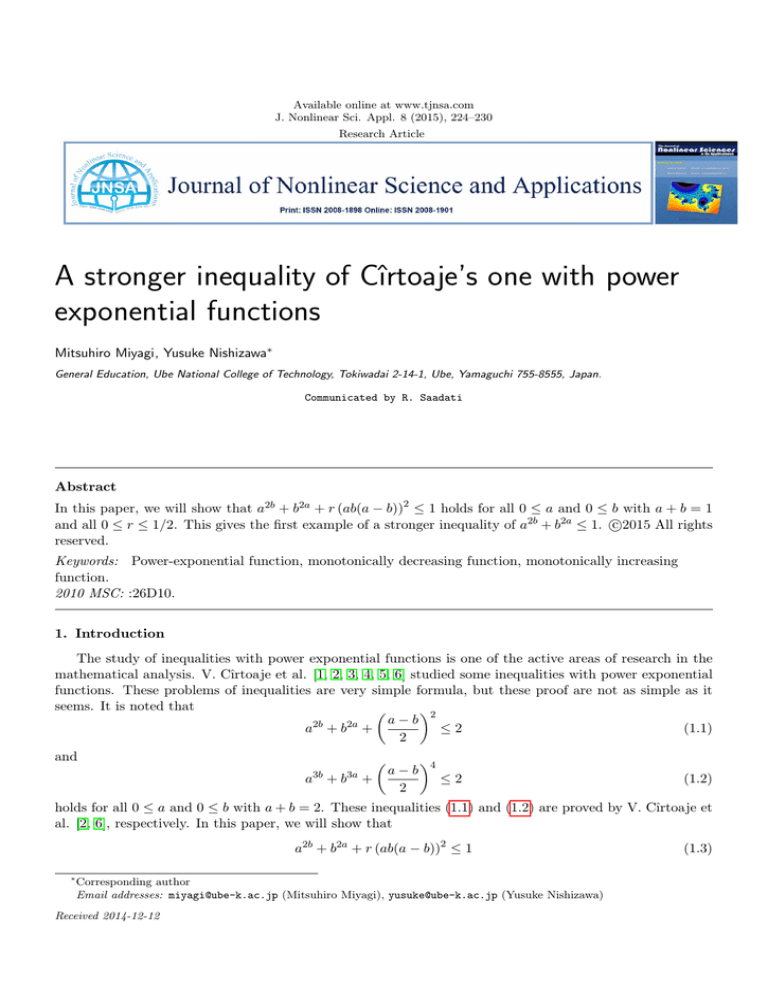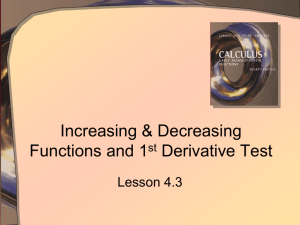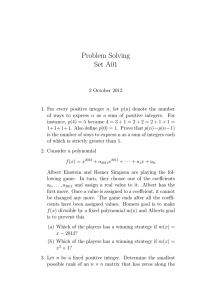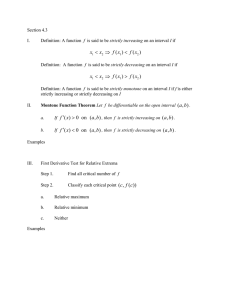
Available online at www.tjnsa.com
J. Nonlinear Sci. Appl. 8 (2015), 224–230
Research Article
A stronger inequality of Cı̂rtoaje’s one with power
exponential functions
Mitsuhiro Miyagi, Yusuke Nishizawa∗
General Education, Ube National College of Technology, Tokiwadai 2-14-1, Ube, Yamaguchi 755-8555, Japan.
Communicated by R. Saadati
Abstract
In this paper, we will show that a2b + b2a + r (ab(a − b))2 ≤ 1 holds for all 0 ≤ a and 0 ≤ b with a + b = 1
c
and all 0 ≤ r ≤ 1/2. This gives the first example of a stronger inequality of a2b + b2a ≤ 1. 2015
All rights
reserved.
Keywords: Power-exponential function, monotonically decreasing function, monotonically increasing
function.
2010 MSC: :26D10.
1. Introduction
The study of inequalities with power exponential functions is one of the active areas of research in the
mathematical analysis. V. Cı̂rtoaje et al. [1, 2, 3, 4, 5, 6] studied some inequalities with power exponential
functions. These problems of inequalities are very simple formula, but these proof are not as simple as it
seems. It is noted that
a−b 2
2b
2a
a +b +
≤2
(1.1)
2
and
a−b 4
3b
3a
a +b +
≤2
(1.2)
2
holds for all 0 ≤ a and 0 ≤ b with a + b = 2. These inequalities (1.1) and (1.2) are proved by V. Cı̂rtoaje et
al. [2, 6], respectively. In this paper, we will show that
a2b + b2a + r (ab(a − b))2 ≤ 1
∗
Corresponding author
Email addresses: miyagi@ube-k.ac.jp (Mitsuhiro Miyagi), yusuke@ube-k.ac.jp (Yusuke Nishizawa)
Received 2014-12-12
(1.3)
M. Miyagi, Y. Nishizawa, J. Nonlinear Sci. Appl. 8 (2015), 224–230
225
holds for all 0 ≤ a and 0 ≤ b with a + b = 1 and all 0 ≤ r ≤ 1/2, which is a stronger inequality of
a2b + b2a ≤ 1.
(1.4)
The above inequality (1.4) is Conjecture 4.8 in [2] and proved by V. Cı̂rtoaje [3]. The following is our main
theorem.
Theorem 1.1. For all 0 ≤ a and 0 ≤ b with a + b = 1 and all 0 ≤ r ≤ 1/2, the inequality (1.3) holds.
This gives the first example of a stronger inequality of (1.4).
2. Proof of Theorem 1.1
Proof. Without loss of generically, we assume that
0≤b≤
1
≤ a ≤ 1.
2
Applying Lemma 7.1 in [3], we have
a2b ≤ 1 − 4ab2 − 2ab(a − b)ln a
and since the inequality (1.3) is strictly increasing for 0 ≤ r ≤ 1/2, it suffices to show that
b2a +
1
(ab(a − b))2 ≤ 4ab2 + 2ab(a − b)ln a.
2
(2.1)
We assume that a = (1 + t)/2 and b = (1 − t)/2, where 0 ≤ t ≤ 1. Here, the inequality (2.1) is equivalent to
1
1
1 − t t+1
+ (−1 + t)2 (1 + t) −16 + t2 + t3 + (1 − t)t(1 + t)(ln (1 + t) − ln 2) ≤ 0.
2
32
2
Moreover, from Lemma 2.1 in [6], we have
1
(1 − t)1+t ≤ (1 − t)2 (2 − t2 )(2 + 2t + t2 )
4
and by the well known fact we have
2−t = e−t ln 2
((ln 2)t)2 ((ln 2)t)3 ((ln 2)t)4
−
+
− ···
2
3!
4!
((ln 2)t)2 ((ln 2)t)3 ((ln 2)t)4
≤ 1 − (ln 2)t +
−
+
.
2
3!
4!
= 1 − (ln 2)t +
Therefore, it suffices to show that
((ln 2)t)2 ((ln 2)t)3 ((ln 2)t)4
1
1 − (ln 2)t +
−
+
F (t) :=
2
2
3!
4!
1
1
× (1 − t)2 (2 − t2 )(2 + 2t + t2 ) + (−1 + t)2 (1 + t) −16 + t2 + t3
4
32
1
+ (1 − t)t(1 + t)(ln (1 + t) − ln 2) ≤ 0.
2
We have the fourth derivated function
F (4) (t) =
d4
f (t)
F (t) =
dt4
(t + 1)3
M. Miyagi, Y. Nishizawa, J. Nonlinear Sci. Appl. 8 (2015), 224–230
226
of F (t), where
f (t) =62 + 126t − 33t2 − 375t3 − 405t4 − 135t5
+ 12(1 + t)3 −2 − 15t + 35t3 (ln 2)
− 6(1 + t)3 4 − 10t − 45t2 + 70t4 (ln 2)2
+ 2(1 + t)3 4 + 20t − 30t2 − 105t3 + 126t5 (ln 2)3
− (1 + t)3 −2 + 10t + 30t2 − 35t3 − 105t4 + 105t6 (ln 2)4 .
Then, we have derivatives
f (6) (t) = − 5040 − 60 − 78(ln 2)2 − 756t(ln 2)2 − 1008t2 (ln 2)2 − 35(ln 2)3
+ 180(ln 2) + 420t(ln 2) + 210t(ln 2)3 + 1260t2 (ln 2)3 + 1260t3 (ln 2)3
Since
69
7
< ln 2 < ,
100
10
we have
− 60 − 78(ln 2)2 − 756t(ln 2)2 − 1008t2 (ln 2)2 − 35(ln 2)3
+ 180(ln 2) + 420t(ln 2) + 210t(ln 2)3 + 1260t2 (ln 2)3 + 1260t3 (ln 2)3
2
2
2
3
7
7
7
7
2
> −60 − 78
− 756t
− 1008t
− 35
10
10
10
10
3
69
69
69
69 3
69 3
2
3
+ 180
+ 420t
+ 210t
+ 1260t
+ 1260t
100
100
100
100
100
1
=
(1397500 − 1165311t − 7999866t2 + 41392134t3 )
100000
1
(1300000 − 1200000t − 8000000t2 + 40000000t3 )
>
100000
= 13 − 12t − 80t2 + 400t3 .
We set
f˜(t) = 13 − 12t − 80t2 + 400t3
then we have
f˜0 (t) = 4 −3 − 40t + 300t2 .
Since
f˜0
we have
√ !
2 − 13
=0
30
and f˜0
√ !
2 + 13
= 0,
30
√ !
13 ∼
2
+
f˜(t) ≥ f˜
= 10.5742.
30
Hence, we can get
f (6) (t) < 0.
Thus, f (5) (t) is strictly decreasing for 0 < t < 1. We have
f (5) (t) = −16200 + 151200(1 + 2t)(ln 2)
− 10800 11 + 84t + 98t2 (ln 2)2
+ 720 −73 + 546t + 2646t2 + 2352t3 (ln 2)3
− 3600 −13 − 49t + 147t2 + 588t3 + 441t4 (ln 2)4 ,
M. Miyagi, Y. Nishizawa, J. Nonlinear Sci. Appl. 8 (2015), 224–230
227
f (5) (0) = −16200 + 151200(ln 2) − 118800(ln 2)2 − 52560(ln 2)3 + 46800(ln 2)4
∼
= 24825.3,
and
f (5) (1) = −16200 + 453600(ln 2) − 2084400(ln 2)2 + 3939120(ln 2)3 − 4010400(ln 2)4
∼
= −317162.
Since f (5) (t) is strictly decreasing for 0 < t < 1, there exists uniquely a real number 0 < t1 < 1 such that
f (5) (t1 ) = 0. Since f (5) (t) > 0 for 0 < t < t1 and f (5) (t) < 0 for t1 < t < 1, f (4) (t) is strictly increasing for
0 < t < t1 and f (4) (t) is strictly decreasing for t1 < t < 1. We have
f (4) (t) = −9720 − 16200t
+ 4320 6 + 35t + 35t2 (ln 2)
− 3600 −3 + 33t + 126t2 + 98t3 (ln 2)2
+ 240 −77 − 219t + 819t2 + 2646t3 + 1764t4 (ln 2)3
− 120 −22 − 390t − 735t2 + 1470t3 + 4410t4 + 2646t5 (ln 2)4 ,
f (4) (0) = −9720 + 25920(ln 2) + 10800(ln 2)2 − 18480(ln 2)3 + 2640(ln 2)4
∼
= 7890.38
and
f (4) (1) = −25920 + 328320(ln 2) − 914400(ln 2)2 + 1183920(ln 2)3 − 885480(ln 2)4
∼
= −47797.5.
Since f (4) (t) is strictly increasing for 0 < t < t1 and f (4) (t) is strictly decreasing for t1 < t < 1, there exists
uniquely a real number t1 < t2 < 1 such that f (4) (t2 ) = 0. Since f (4) (t) > 0 for 0 < t < t2 and f (4) (t) < 0
for t2 < t < 1, f (3) (t) is strictly increasing for 0 < t < t2 and f (3) (t) is strictly decreasing for t2 < t < 1. We
have
f (3) (t) = −2250 − 9720t − 8100t2
+ 144 −6 + 180t + 525t2 + 350t3 (ln 2)
− 36 −161 − 300t + 1650t2 + 4200t3 + 2450t4 (ln 2)2
+ 12 −131 − 1540t − 2190t2 + 5460t3 + 13230t4 + 7056t5 (ln 2)3
− 6 83 − 440t − 3900t2 − 4900t3 + 7350t4 + 17640t5 + 8820t6 (ln 2)4
f (3) (0) = −2250 − 864(ln 2) + 5796(ln 2)2 − 1572(ln 2)3 − 498(ln 2)4
∼
= −702.644
and
f (3) (1) = −20070 + 151056(ln 2) − 282204(ln 2)2 + 262620(ln 2)3 − 147918(ln 2)4
∼
= 2362.55.
Since f (3) (t) is strictly decreasing for 0 < t < t2 and f (3) (t) is strictly decreasing for t2 < t < 1, there exists
uniquely a real number 0 < t3 < t2 such that f (3) (t3 ) = 0. Since f (3) (t) < 0 for 0 < t < t3 and f (3) (t) > 0
M. Miyagi, Y. Nishizawa, J. Nonlinear Sci. Appl. 8 (2015), 224–230
228
for t3 < t < 1, f (2) (t) is strictly decreasing for 0 < t < t3 and f (2) (t) is strictly increasing for t3 < t < 1. We
have
f (2) (t) = −66 − 2250t − 4860t2 − 2700t3
+ 72(1 + t) −17 + 5t + 175t2 + 175t3 (ln 2)
− 36(1 + t) −21 − 140t − 10t2 + 560t3 + 490t4 (ln 2)2
+ 12(1 + t) 14 − 145t − 625t2 − 105t3 + 1470t4 + 1176t5 (ln 2)3
− 6(1 + t) 18 + 65t − 285t2 − 1015t3 − 210t4 + 1680t5 + 1260t6 (ln 2)4
f (2) (0) = −66 − 1224(ln 2) + 756(ln 2)2 + 168(ln 2)3 − 108(ln 2)4
∼ −520.172
=
and
f (2) (1) = −9876 + 48672(ln 2) − 63288(ln 2)2 + 42840(ln 2)3 − 18156(ln 2)4
∼
= 3529.68
Since f (2) (t) is strictly decreasing for 0 < t < t3 and f (2) (t) is strictly increasing for t3 < t < 1, there exists
uniquely a real number t3 < t4 < 1 such that f (2) (t4 ) = 0. Since f (2) (t) < 0 for 0 < t < t4 and f (2) (t) > 0
for t4 < t < 1, f 0 (t) is strictly decreasing for 0 < t < t4 and f 0 (t) is strictly increasing for t4 < t < 1. We
have
f 0 (t) = 126 − 66t − 1125t2 − 1620t3 − 675t4
+ 36(1 + t)2 −7 − 20t + 35t2 + 70t3 (ln 2)
− 6(1 + t)2 2 − 130t − 225t2 + 280t3 + 490t4 (ln 2)2
+ 2(1 + t)2 32 + 20t − 465t2 − 630t3 + 630t4 + 1008t5 (ln 2)3
− (1 + t)2 4 + 100t + 45t2 − 630t3 − 735t4 + 630t5 + 945t6 (ln 2)4 ,
f 0 (0) = 126 − 252(ln 2) − 12(ln 2)2 + 64(ln 2)3 − 4(ln 2)4
∼
= −34.0483,
and
f 0 (1) = −3360 + 11232(ln 2) − 10008(ln 2)2 + 4760(ln 2)3 − 1436(ln 2)4
∼
= 870.774.
Since f 0 (t) is strictly decreasing for 0 < t < t4 and f 0 (t) is strictly increasing for t4 < t < 1, there exists
uniquely a real number t4 < t5 < 1 such that f 0 (t5 ) = 0. Since, f 0 (t) < 0 for 0 < t < t5 and f 0 (t) > 0 for
t5 < t < 1, f (t) is strictly decreasing for 0 < t < t5 and f (t) is strictly increasing for t5 < t < 1. Since
f (0) = 2 31 − 12(ln 2) − 12(ln 2)2 + 4(ln 2)3 + (ln 2)4 ∼
= 36.9595,
f (1) = −8 95 − 216(ln 2) + 114(ln 2)2 − 30(ln 2)3 + 3(ln 2)4 ∼
= 73.9711,
and
1
1
f
=
20656 − 106272(ln 2) + 81648(ln 2)2 − 9288(ln 2)3 − 2079(ln 2)4
2
512
∼
= −33.889.
M. Miyagi, Y. Nishizawa, J. Nonlinear Sci. Appl. 8 (2015), 224–230
229
Since f (t) is strictly decreasing for 0 < t < t5 and f (t) is strictly increasing for t5 < t < 1, we have only
two real numbers a1 and a2 with 0 < a1 < 1/2 < a2 < 1 such that f (a1 ) = 0 and f (a2 ) = 0. Since f (t) > 0
for all 0 < t < a1 , a2 < t < 1 and f (t) < 0 for all a1 < t < a2 , F (3) (t) is strictly increasing for 0 < t < a1 ,
a2 < t < 1 and F (3) (t) is strictly decreasing for a1 < t < a2 . We have
F (3) (t) =
g(t)
,
(t + 1)2
where
g(t) =200t + 304t2 − 60t3 − 360t4 − 180t5
+ 12t(1 + t)2 −8 − 30t + 35t3 (ln 2)
− 24(1 + t)2 1 + 4t − 5t2 − 15t3 + 14t5 (ln 2)2
+ 2(1 + t)2 −4 + 16t + 40t2 − 40t3 − 105t4 + 84t6 (ln 2)3
− t(1 + t)2 −8 + 20t + 40t2 − 35t3 − 84t4 + 60t6 (ln 2)4
+ 48(1 + t)2 ln (1 + t).
We have
1
F (3) (0) = − (ln 2)2 (3 + ln 2) ∼
= −0.887192,
2
F (3) (1) =
1
−24 + 12(ln 2) + 24(ln 2)2 − 18(ln 2)3 + 7(ln 2)4 ∼
= −0.533122
16
and
F
(3)
1
1
=
(17968 − 46008(ln 2) − 2160(ln 2)2
2
4608
+ 2160(ln 2)3 − 477(ln 2)4 + 13824(ln 3)) ∼
= 0.181499.
Since we have only two real numbers a3 and a4 with 0 < a3 < 1/2 and 1/2 < a4 < 1 such that F (3) (a3 ) = 0
and F (3) (a4 ) = 0, F (3) (t) < 0 for all 0 < t < a3 , a4 < t < 1 and F (3) (t) > 0 for all a3 < t < a4 . Therefore,
F (2) (t) is strictly decreasing for 0 < t < a3 , a4 < t < 1 and F (2) (t) is strictly increasings for a3 < t < a4 .
We have
h(t)
F (2) (t) =
,
96(t + 1)
where
h(t) = − 6 15 + 15t − 76t2 − 60t3 + 45t4 + 45t5
+ 24(1 + t) 4 − 12t2 − 30t3 + 21t5 (ln 2)
− 12(1 + t) −4 + 12t + 24t2 − 20t3 − 45t4 + 28t6 (ln 2)2
+ 4t(1 + t) −12 + 24t + 40t2 − 30t3 − 63t4 + 36t6 (ln 2)3
− t2 (1 + t) −24 + 40t + 60t2 − 42t3 − 84t4 + 45t6 (ln 2)4
+ 288t(1 + t) ln (1 + t).
We have
1
−15 + 16(ln 2) + 8(ln 2)2 ∼
= −0.00412631,
16
1
F (2) (1) =
48 − 120(ln 2) + 60(ln 2)2 − 20(ln 2)3 + 5(ln 2)4 ∼
= −0.123508
96
F (2) (0) =
M. Miyagi, Y. Nishizawa, J. Nonlinear Sci. Appl. 8 (2015), 224–230
230
and
F (2)
1
1
=
(−224 − 49728(ln 2) − 9600(ln 2)2
2
24576
+ 1472(ln 2)3 − 77(ln 2)4 + 36864(ln 3)) ∼
= 0.0678104.
Since we have only two real numbers a5 and a6 with 0 < a5 < 1/2 and 1/2 < a6 < 1 such that F (2) (a5 ) = 0
and F (2) (a6 ) = 0, F (2) (t) < 0 for all 0 < t < a5 , a6 < t < 1 and F (2) (t) > 0 for all a5 < t < a6 . Therefore,
F 0 (t) is strictly decreasing for 0 < t < a5 , a6 < t < 1 and F 0 (t) is strictly increasing for a5 < t < a6 . We
have
p(t)
F 0 (t) =
,
96
where
p(t) = − 6(−1 + t)2 t 7 + 18t + 9t2
+ 12t(8 − 8t2 − 15t3 + 7t5 )(ln 2)
− 12(−1 + t)t 4 − 2t − 10t2 − 5t3 + 4t4 + 4t5 (ln 2)2
+ 2(−1 + t)t2 12 − 4t − 24t2 − 12t3 + 9t4 + 9t5 (ln 2)3
− (−1 + t)t3 8 − 2t − 14t2 − 7t3 + 5t4 + 5t5 (ln 2)4
+ 48 −1 + 3t2 ln (1 + t)
We have
F 0 (0) = 0
and
F 0 (1) = 0.
Since there exists uniquely a real number a7 with 0 < a7 < 1 such that F 0 (a7 ) = 0, F (t) is strictly decreasing
for 0 < t < a7 and F (t) is strictly increasing for a7 < t < 1 Hence, we can get
F (t) ≤ max{F (0), F (1)}.
Since F (0) = F (1) = 0, we have F (t) ≤ 0 for all 0 ≤ t ≤ 1. Therefore, the proof of Theorem 1.1 is
completed.
Problem 2.1. What is the maximum value of a nonnegative real number r in the inequality a2b + b2a +
r (ab(a − b))2 ≤ 1 for all nonnegative real numbers a and b with a + b = 1 ?
References
[1] A. Coronel, F. Huancas On the inequality a2a + b2b + c2c ≥ a2b + b2c + c2a , Aust. J. Math. Anal. Appl., 9 (2012),
5 pages. 1
[2] V. Cı̂rtoaje, On some inequalities with power-exponential functions, JIPAM. J. Inequal. Pure Appl. Math., 10
(2009), 6 pages. 1, 1, 1
[3] V. Cı̂rtoaje, Proofs of three open inequalities with power-exponential functions, J. Nonlinear Sci. Appl., 4 (2011),
130–137. 1, 1, 2
[4] L. Matejicka, Proof of one open inequality, J. Nonlinear Sci. Appl., 7 (2014), 51–62. 1
[5] M. Miyagi, Y. Nishizawa, Proof of an open inequality with double power-exponential functions, J. Inequal. Appl.,
2013 (2013), 11 pages. 1
[6] M. Miyagi, Y. Nishizawa, A short proof of an open inequality with power-exponential functions, Aust. J. Math.
Anal. Appl., 11 (2014), 3 pages.






